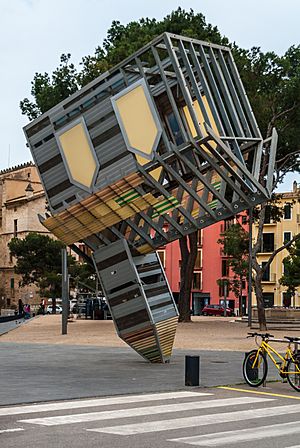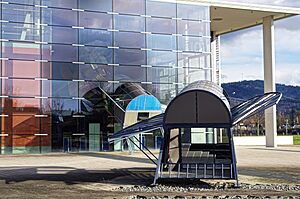Dennis Oppenheim facts for kids
Quick facts for kids
Dennis Oppenheim
|
|
|---|---|
| Born | September 6, 1938 |
| Died | January 21, 2011 (aged 72) New York City, U.S.
|
| Nationality | American |
| Education | California College of Arts and Crafts, Stanford University |
| Known for | Sculpture, performance art |
| Movement | Conceptual art, environmental art |
Dennis Oppenheim (born September 6, 1938 – died January 21, 2011) was an American artist. He was known for many types of art. These included conceptual art, performance art, and earth art. He was also a sculptor and photographer. Oppenheim's early art explored what art is and how it is made. Later, his work often became large public sculptures. He had a very active career with many different kinds of art.
Contents
About Dennis Oppenheim's Life
Oppenheim was born in Electric City, Washington. His father was an immigrant from Russia. His mother was from California. His father worked as an engineer on the Grand Coulee Dam. After Dennis was born, his family moved back to the San Francisco Bay area. He went to Richmond High School.
Dennis Oppenheim studied at the California College of Arts and Crafts. There, he met his first wife, Karen Marie Cackett. They moved to Honolulu, where he taught at the University of Hawaii. Their first child, Kristin, was born in 1959. Their second child, Erik, was born in 1962.
In 1964, he earned his Bachelor of Fine Arts degree. He then got his Master of Fine Arts degree from Stanford University in 1965. In 1966, he moved to New York. He taught art at a nursery school and a junior high school. His first art show in New York was in 1968. His third child, Chandra, was born that same year.
In 1981, he married sculptor Alice Aycock. They remained good friends after their marriage ended. In 1998, he married Amy Plumb. They stayed married until his death. Oppenheim lived and worked in a loft in Tribeca, New York, from 1967. He passed away from cancer on January 21, 2011, at age 72.
Dennis Oppenheim's Artworks
Dennis Oppenheim created many different kinds of art. He explored new ways to make and show art.
Conceptual Art Ideas
In 1968, Oppenheim created a series called Indentations. He took objects away and showed the marks they left behind. This was done in New York, Paris, and Amsterdam. His Viewing Stations (1967) were platforms built to look at landscapes. They made the viewer feel like they were part of the art.
Earth Art Projects
Oppenheim used natural places for his earth art. He often combined ideas about society with nature. In Annual Rings (1968), he plowed lines in the snow. These lines showed the yearly growth rings of a tree. He made them on both sides of the St. John's River. This river is the border between the U.S. and Canada. This artwork connected borders, time, and nature's growth.
Body and Performance Art
Oppenheim's body art came from his work with earth art. In these pieces, his own body became the art. This gave him full control over the artwork. These body art actions later became part of performance art. For example, in Reading Position for Second Degree Burn (1970), he lay on a beach. He had an open book on his chest for five hours. He let the sun burn his skin. He said this was like painting, where he could feel himself "becoming red."
Art with Family
Oppenheim also made art with his children. He saw them as part of himself. In a work called 2- Stage Transfer Drawing. (Advancing to a Future State), he drew on a wall. At the same time, his son tried to draw the same thing on his father's back. In another version, 2- Stage Transfer Drawing. (Returning to a Past State) (1971), the roles were switched. These performances were shown using photos, film, and video. He also worked with his first wife in Forming Sounds (1972). He even included his father, David Oppenheim, in works like Polarties (1972).
Film and Video Art
In the early 1970s, Oppenheim started making installation art. These works often told stories about his own life. In Recall (1974), a video showed his mouth speaking. He talked about his art school experiences from the 1950s. He did this while smelling turpentine, which helped him remember.
Later Performance Art
Oppenheim created a series of "post-performance" works. In these, he used figures to act out his ideas about art. In Theme for a Major Hit (1974), motorized figures moved to a rock song. The song had his lyrics: "It ain’t what you do, it’s what makes you do it." This work explored how art is made and what makes artists create.
Machine-Inspired Art
In the early 1980s, Oppenheim made large sculptures that looked like factories or machines. These showed how an artwork comes to life. Final Stroke- Project for a Glass Factory (1981) showed thinking patterns as moving parts. Machines with vacuum cleaners and heaters moved materials. This showed the steps of creating ideas. These machines sometimes even shot fireworks into the air. This was like showing "thought lines," as in Newton Discovering Gravity (1984).
Sculptures
Oppenheim continued to use sound, light, and movement in his sculptures. In the late 1980s, his art began to include everyday objects. These objects were often shown in different sizes or crashed together. He also included animals in some works. For example, in Digestion. Gypsum Gypsies. (1989), stuffed deer had flames coming from their antlers.
Public Sculptures for Everyone
Oppenheim made many large sculptures for public places. He often made them lean or tilt, like in Device to Root Out Evil (1997). This sculpture was shown at the Venice Biennale. It used hand-blown glass on a church roof and steeple. A version made of fiberglass was later put in Palma de Mallorca permanently.

His public art often fit with the building or area it was in. Jump and Twist (1999) is a three-part sculpture. It goes from a plaza, through a building's wall, and hangs from the ceiling inside. Light Chamber (2011) is another public work. It is an open room with see-through walls. These walls look like flower petals. It is located at the Justice Center in Denver.
See also
 In Spanish: Dennis Oppenheim para niños
In Spanish: Dennis Oppenheim para niños
- Engagement (sculpture)
- Radiant Fountains, Houston, Texas
- Formula compound, Fattoria di Celle- Collezione Gori, Pistoia


